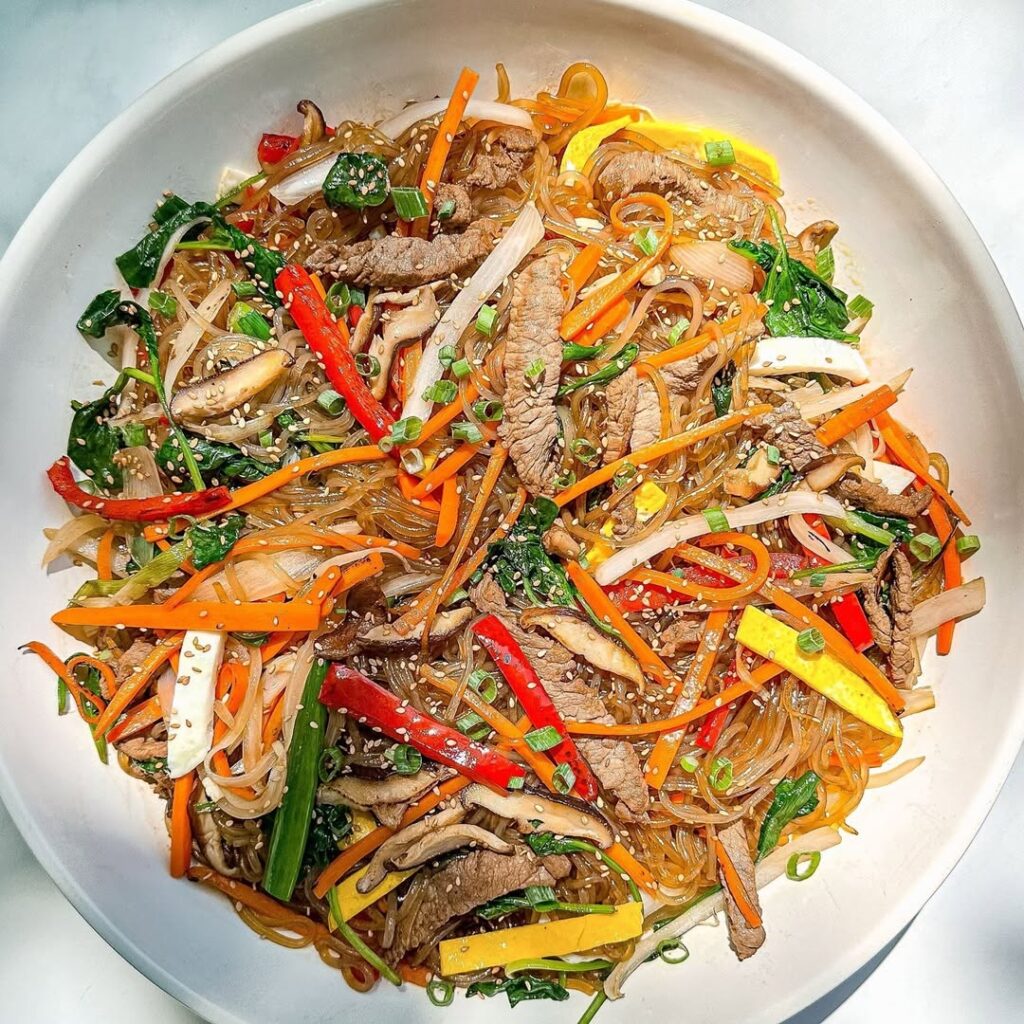Korean Japchae Recipe – If you’re looking to experience the colorful, savory-sweet world of Korean cuisine, look no further than the Korean Japchae Recipe. A beloved classic in Korean households and celebrations, Japchae (잡채) is a flavorful stir-fried noodle dish made with glass noodles (dangmyeon), marinated beef, and an assortment of vegetables.

Japchae is often served at birthdays, weddings, and holidays like Chuseok and Lunar New Year, symbolizing prosperity and happiness. Its glossy noodles, vibrant vegetables, and perfectly balanced flavors make it both comforting and elegant.
Recipe Overview
Prep Time: 25 minutes
Active Cooking Time: 20 minutes
Resting Time: 5 minutes
Total Time: 50 minutes
Cuisine: Korean
Course: Main Course / Side Dish
Servings: 4 servings
Calories: Approximately 480 kcal per serving
Ingredients
For the Noodles & Sauce:
-
Sweet potato glass noodles (dangmyeon) – 200 g (7 oz)
-
Soy sauce – 4 tablespoons
-
Sugar – 2 tablespoons
-
Sesame oil – 2 tablespoons
-
Garlic – 3 cloves, minced
-
Ground black pepper – ¼ teaspoon
For the Beef (Optional for Non-Vegans):
-
Beef (ribeye or sirloin), thinly sliced – 150 g (5 oz)
-
Soy sauce – 1 tablespoon
-
Sugar – ½ tablespoon
-
Sesame oil – ½ tablespoon
-
Garlic – 1 clove, minced
For the Vegetables:
-
Carrot – 1 medium, julienned
-
Onion – 1 small, thinly sliced
-
Spinach – 2 cups (blanched and squeezed)
-
Shiitake mushrooms – 4–5, thinly sliced
-
Red bell pepper – ½, julienned
-
Green onions – 2, chopped
-
Cooking oil – 2 tablespoons
-
Salt – to taste
Garnish:
-
Toasted sesame seeds – 1 tablespoon
-
Optional: Thin omelet strips for decoration
Equipment Needed
-
Large pot for boiling noodles
-
Wok or large skillet
-
Mixing bowls
-
Tongs or chopsticks for mixing
-
Strainer
-
Cutting board and knife
Instructions
Step 1: Prepare the Noodles
Bring a large pot of water to a boil. Add the sweet potato noodles and cook for 6–7 minutes or until tender but chewy. Drain and rinse with cold water to stop the cooking process.
Drizzle 1 teaspoon of sesame oil over the noodles to prevent sticking, then cut them slightly with scissors for easier eating. Set aside.
Step 2: Marinate the Beef
In a small bowl, combine soy sauce, sugar, sesame oil, and minced garlic. Add the thinly sliced beef and marinate for about 10–15 minutes. This step ensures tender and flavorful meat.
Step 3: Prepare the Vegetables
Blanch the spinach in boiling water for 30 seconds, then rinse immediately in cold water. Squeeze out excess water, season lightly with a pinch of salt and a few drops of sesame oil, and set aside.
Heat a wok or skillet with a bit of oil. Stir-fry each vegetable (carrot, onion, mushrooms, and bell pepper) separately over medium-high heat for 2–3 minutes each. Lightly season each batch with a pinch of salt before removing them. Cooking them separately keeps colors vibrant and textures crisp.
Step 4: Cook the Beef
In the same pan, add the marinated beef and stir-fry until fully cooked and browned, about 3–4 minutes. Set aside.
Step 5: Make the Sauce
In a small bowl, mix together soy sauce, sugar, sesame oil, minced garlic, and a pinch of pepper. This will be your final seasoning sauce for the dish.
Step 6: Combine Everything
Return the cooked noodles to the wok or a large mixing bowl. Pour the sauce over the noodles and toss well until evenly coated.
Add the cooked beef, stir-fried vegetables, and seasoned spinach. Toss gently until everything is well mixed. Taste and adjust seasoning with more soy sauce or sesame oil if needed.
Step 7: Serve and Garnish
Transfer the Japchae to a serving platter. Sprinkle toasted sesame seeds on top for aroma and crunch. Add thin omelet strips or green onions for a decorative touch.
Serve warm or at room temperature — both ways are equally delicious.
Nutrition Information (Per Serving)
| Nutrient | Amount (Approx.) |
|---|---|
| Calories | 480 kcal |
| Carbohydrates | 60 g |
| Protein | 15 g |
| Fat | 18 g |
| Saturated Fat | 3 g |
| Cholesterol | 30 mg |
| Sodium | 850 mg |
| Fiber | 4 g |
| Sugar | 10 g |
Serving Suggestions
Japchae is incredibly versatile and can be served in many ways:
-
As a main dish: With kimchi and a bowl of rice for a satisfying meal.
-
As a side dish: Alongside Korean BBQ, bulgogi, or bibimbap.
-
For parties: Serve Japchae on a large platter — it’s beautiful, colorful, and a crowd-pleaser.
Conclusion
The Korean Japchae Recipe is a perfect introduction to the beauty of Korean home cooking. It’s colorful, healthy, and deeply flavorful — combining sweet, salty, and savory notes with chewy noodles and crisp vegetables.
